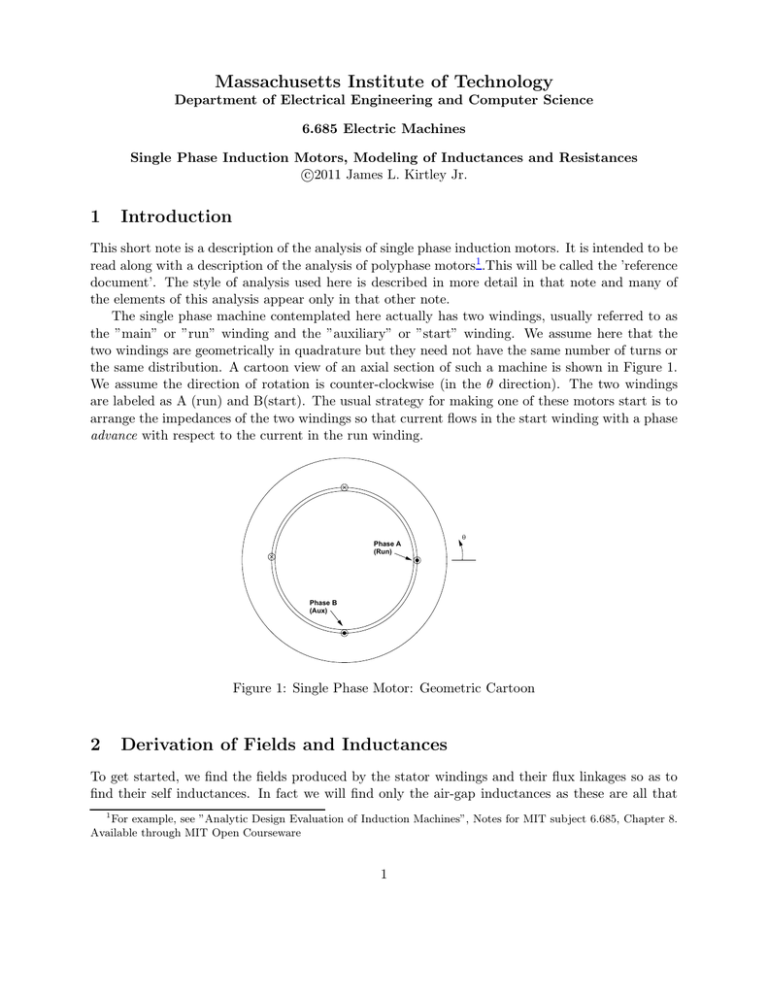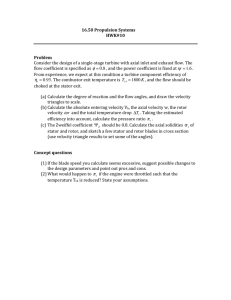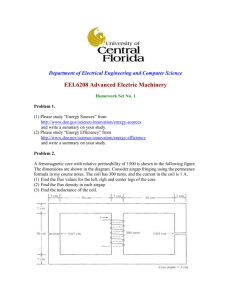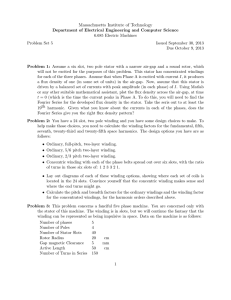Massachusetts Institute of Technology
advertisement

Massachusetts Institute of Technology Department of Electrical Engineering and Computer Science 6.685 Electric Machines Single Phase Induction Motors, Modeling of Inductances and Resistances c 2011 James L. Kirtley Jr. 1 Introduction This short note is a description of the analysis of single phase induction motors. It is intended to be read along with a description of the analysis of polyphase motors1 .This will be called the ’reference document’. The style of analysis used here is described in more detail in that note and many of the elements of this analysis appear only in that other note. The single phase machine contemplated here actually has two windings, usually referred to as the ”main” or ”run” winding and the ”auxiliary” or ”start” winding. We assume here that the two windings are geometrically in quadrature but they need not have the same number of turns or the same distribution. A cartoon view of an axial section of such a machine is shown in Figure 1. We assume the direction of rotation is counter-clockwise (in the θ direction). The two windings are labeled as A (run) and B(start). The usual strategy for making one of these motors start is to arrange the impedances of the two windings so that current flows in the start winding with a phase advance with respect to the current in the run winding. Phase A (Run) θ Phase B (Aux) Figure 1: Single Phase Motor: Geometric Cartoon 2 Derivation of Fields and Inductances To get started, we find the fields produced by the stator windings and their flux linkages so as to find their self inductances. In fact we will find only the air-gap inductances as these are all that 1 For example, see ”Analytic Design Evaluation of Induction Machines”, Notes for MIT subject 6.685, Chapter 8. Available through MIT Open Courseware 1 are required for this explication. Of course analytical evaluation of machine operation will require evaluation of leakage inductances too. With the geometry shown in Figure 1, radial magnetic flux density in the air-gap is: Br = X n odd 4 µ0 nπ Na ia Nb ib π kwna sin npθ + kwnb sin n cos npθ 2pg 2pg 2 where Na is the number of turns in the main winding, Nb is the number of turns in the auxiliary winding, p is the number of pole pairs, g is the effective air-gap and kwna and kwnb are the winding factors for the nth harmonic fields of the two windings, respectively. Winding factors will be dealt with later. To estimate inductance we need to compute flux linkages of the two windings. The flux linkages for the nth harmonic fields are: λan = ℓ Z λbn = ℓ Z 0 −π p Na kwna Brn (θ)Rdθ π 2p π − 2p Nb kwnb Brn (θ)Rdθ Here, we have used the symbol ℓ to describe the axial length of the machine. To estimate winding self inductance, in which we ignore any currents that might be flowing in the rotor, we find the nth space harmonic flux linkages to be (no surprise here): 2 Rℓ 4 Na2 kwna ia 2 π n p2 g 2 Rℓ 4 Nb2 kwnb = µ0 ib π n 2 p2 g λan = µ0 λbn Where R is radius of the air-gap. At this point we define the effective turns ratio αn = sin n π Nb kwnb 2 Na kwna so that the nth harmonic inductances of the windings are: 2 Rℓ 4 Na2 kwna π n 2 p2 g 2 Rℓ 4 Nb2 kwnb = µ0 = α2n Lan π n 2 p2 g Lan = µ0 Lbn Note the sign of the effective turns ratio, which does not affect the self inductances but does affect the direction of rotation of the various magnetic field components. Harmonics number 3 and 7 (and one of the zigzag components) rotate in the reverse direction than would be indicated by the sequence order of currents in the stator windings. 2 3 Squirrel-Cage Model In the single phase motor we must deal with a number of space harmonics with positive and negative phase velocities. This analytical description will deal with one such component. The squirrel cage is made up of a number (NR ) of discrete conductors (’bars’), each carrying a current that will be of the form (in bar k): n o ik = Re I k ejωr t Depending on the direction of the current wave the bar current will be of the form: ∓j 2πnpk N I k = I 0e R As is shown in the reference document, this set of discrete currents is equivalent to a number of space harmonics of surface current: Kz = Re ( X N R I0 2πR n j(ωr t∓npθ ′ ) e ) The values of n for which Kz is non-zero are n = 1 + integer × NR p and they will produce magnetic flux across the air-gap: B rn = ∓jµ0 N R I0 2πnpg Electric field induced by these fields is: En = ± ωr R µ 0 NR ω r R B n = −j I np 2πgn2 p2 0 If we assume, as in the reference document, that only the smallest order terms (n = 1, n = 1 ± NpR ) contribute substantially to the electric field driving current through the rotor conductor, E 1 + E n+ + E n− = Zslot I 0 Now we need to put this back into the form of an equivalent circuit. Note that the space fundamental field is caused by currents in the stator as well as the rotor but that the higher order space harmonic voltage components are produced only by rotor currents. To refer the rotor current back to the stator, note that, if a current IF were in the stator it would make a magnetic field: B r = − µ0 4 Na I F kwna π 2pg then the correct turns ratio to refer rotor current to the stator is: I0 = 4Na kwna IF NR 3 So now the space fundamental component of electric field seen from the rotor is: E1 = 4Na kw1a 2 µ0 Na kwna R + jωr NR π g 1 1 + (NR + p)2 (NR − p)2 IF Finally, to relate stator air-gap voltage to rotor electric field, we must do two things: first, translate electric field according to relative frequencies between rotor and stator and integrate over the length of the winding. The result is: ω V ag = −2ℓNa kw1a E 1 ωr The equivalent circuit elements for the rotor are then just: R2 = X2 = 2 8ℓNa2 kw1a Rslot NR 2 2 Rℓ 8ℓNa2 kw1a 4 µ0 Na2 kw1a 1 1 ωLslot + ω + NR π g (NR + p)2 (NR − p)2 Note that the slot resistance and reactance parameters may be frequency dependent and some care must be taken to compute those parameters at the right frequency. Note also that the same extension to space harmonics used for polyphase machines in the reference document will be useful here. Note, however, that the triplen harmonics will, in general, be present and important in the single phase machine, unlike three phase motors. Thus the magnetizing inductance, slot leakage and rotor resistance for the higher order harmonic terms will be of the form: Lagn = X2,n = R2,n = 2 Rℓ 4 µ0 Na2 kwan π n 2 p2 g 2 2 2 Rℓ 8ℓNa kwna 1 1 4 µ0 Na2 kwna + ωLxlot + ω (NR + np)2 (NR − np)2 NR π g 2 8ℓNa2 kwna Rslot NR Note that rotor resistance must be corrected for end ring effects as described in the reference document. 4 Winding Factor In the single phase machines the windings can be described as ’concentric’, or as a collection of some number of coils, all with the same axis, with different coil throws and perhaps a different number of turns. If we denote Ns (k) as the number of turns in coil k and Nc (k) as the coil throw, then the total number of turns is just the sum of all of the Ns ’s and the electrical span angle for coil k is 2pπNc (k) φk = S where S is the total number of slots in the stator (this assumes the slots have equal spacing, which may be a limitation here). The winding factor is then the weighted sum of the winding factors of all of the coils: 4 X Na = Ns (k) k X Ns (k) kwna = Na k 5 sin nφk 2 Skew Often, rotors are skewed, in which case the rotor and stator link different fluxes. The self inductance will be what is computed in this note but the mutual inductances will be modified by the skew factor. The difference beween self and mutual inductance must be treated as leakage inductance. If the skew from one end of the rotor to the other is, in electrical degrees, θsk , the skew factor for the nth harmonic can be shown to be: ksn = sin( nθ2sk ) ( nθ2sk ) The magnetizing and leakage inductance components are then: 2 Xφn = ωLagn ksn 2 X1n = ωLagn (1 − ksn ) 6 Operation: Fundamental only Admitting that space harmonics may be important here, we outline operation considering the space fundamental only. Space harmonics can be added conveniently once the basic operation is understood. The coordinate system shown in Figure 2 is used. f a r φ φ b Figure 2: Rotating Field Coordinates If we assume that the two stator phases are noted as a and b and two equivalent rotor phases are A and B, flux linkages are: λa = La ia + Lφ iA λb = Lb ib + αLφ iB λA = Lφ ia + LA iA λB = αLφ ib + LA iB 5 where we have assumed that the rotor equivalent winding has the same number of turns and winding factor as the run winding of the stator. Now this is not a convenient set to use because the interaction of the rotor makes the equivalent phases A and B difficult to use. So we will formulate a coordinate transformation. Working in complex amplitudes, we assume that the equivalent quantities in the rotor coordinates are the sum of components rotating forward and backward: " IA IB # 1 = 2 " 1 1 j −j #" IF IR # The inverse transformation is: " IF IR # = " 1 −j 1 j #" IA IB # Then the complex amplitudes of flux linkages are: Lφ Lφ IF + I 2 2 R jαLφ jαLφ = Lb I b + IF − IR 2 2 = Lφ I a − jαLφ I b + LA I F Λa = La I a + Λb ΛF ΛR = Lφ I a + jαLφ I b + LA I R Voltage equations are, in the stator coordinate system: jXφ jXφ IF + I 2 2 R αXφ αXφ V b = (jXb + Rb )I b − I + I 2 F 2 R jXφ αXφ jXA R2 + IF 0 = Ia + Ib + 2 2s 2 2 jXφ αXφ jXA R2 I 0 = Ia − Ib + + 2 2(2 − s) R 2 2 V a = (jXa + Ra )I a + This set of four linear equations is readily solved for the four currents Ia , Ib , IF and IR . To find mechanical energy converted, see that air-gap power and power dissipated on the rotor are, (working in RMS): R2 R2 + |IR |2 2s 2(2 − s) R R2 2 Pd = |IF |2 + |IR |2 2 2 Mechanical energy converted is the difference: R2 R2 Pm = |IF |2 (1 − s) − |IR |2 (1 − s) 2s 2(2 − s) Pag = |IF |2 and torque is Tm p p R2 R2 = Pm = |IF |2 − |IR |2 ω(1 − s) ω 2s 2(2 − s) 6 7 Operation With Space Harmonics The space harmonics couple together only in the stator winding which produces the space harmonic fields in response to armature currents. They are independent of each other in the rotor, however. The coupling is reflected in an addition of all of the harmonic components in the production of voltage in the stator. Each rotating component (forward and backward at each harmonic order) will have its own voltage balance equation. Considering only one of the harmonics, which we will refer to as n, the voltage equations become: jXφ jXφ jXφn jXφn I + I + IF n + I Rn 2 F 2 R 2 2 αXφ αXφ αn Xφn αn Xφn (jXb + Rb )I b − IF + IR − IF n + I Rn 2 2 2 2 jXφ αXφ jXA R2 Ia + Ib + + IF 2 2 2 2s jXφ αXφ jXA R2 I − I + + I 2 a 2 b 2 2(2 − s) R jXφn αn Xφn jXAn R2,n Ia + Ib + + IF n 2 2 2 2sn+ jXφn αn Xφn jXAn R2,n + I Rn Ia − Ib + 2 2 2sn− 2 V A = (jXa + Ra )I a + VB = 0 = 0 = 0 = 0 = Harmonic slips are the ratio between rotor frequency and stator frequency and are: sn+ = ns − (n − 1) sn− = (n + 1) − ns Torques from the space harmonics are estimated in the same way as for the fundamental: air-gap and dissipated power are: R2 R2 + |IRn |2 2sn+ 2sn− R R 2 2 = |IF n |2 + |IRn |2 2 2 Pag = |IF n |2 Pd Inserting the definition for harmonic order slip, we find torque due to the nth harmonic is: Tmn = np R2 R2 |IF n |2 − |IRn |2 ω 2sn+ 2sn− Adding harmonic terms is straightforward and though, if there are a lot of space harmonics considered, it yields a relatively large coupling matrix, the resulting linear equation set is straightforward to solve. Generally, in a single phase motor the auxiliary circuit is connected to an external impedance (e.g. a capacitor or parallel combination of a capacitor and a resistor) and then to the same voltage source as the main winding. The resulting set of expressions is then: 7 jXφ jXφ jXφn jXφn IF + IR + IF n + I Rn 2 2 2 2 αXφ αXφ αn Xφn αn Xφn (jXb + Rb + Ze )I b − IF + IR − IF n + I Rn 2 2 2 2 jXφ αXφ jXA R2 Ia + Ib + + IF 2 2 2 2s jXφ αXφ jXA R2 I − I + + I 2 a 2 b 2 2(2 − s) R jXφn αn Xφn jXAn R2,n Ia + Ib + + IF n 2 2 2 2sn+ jXφn αn Xφn jXAn R2,n Ia − Ib + + I Rn 2 2 2 2sn− V = (jXa + Ra )I a + V = 0 = 0 = 0 = 0 = where Ze is the value of the external impedance element. 8 MIT OpenCourseWare http://ocw.mit.edu 6.685 Electric Machines Fall 2013 For information about citing these materials or our Terms of Use, visit: http://ocw.mit.edu/terms.




